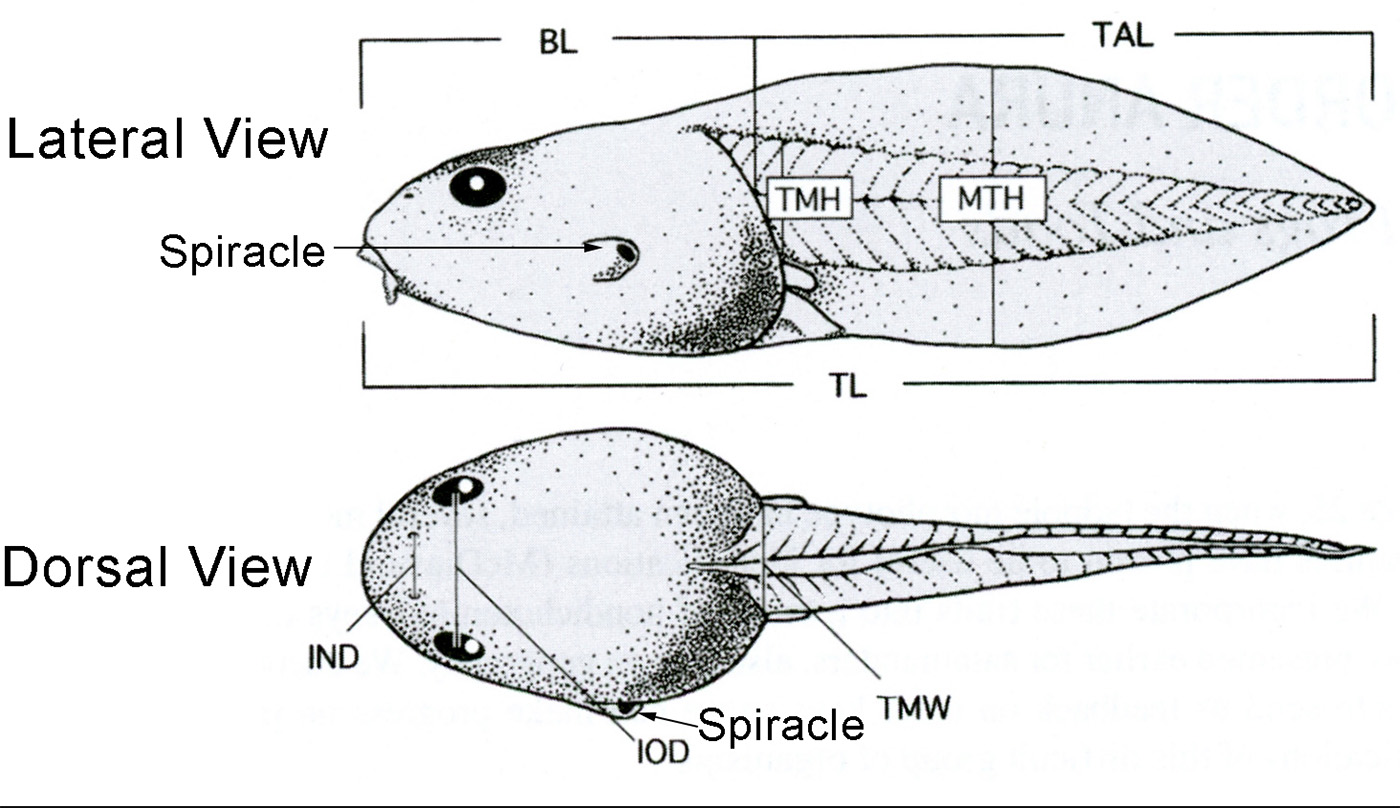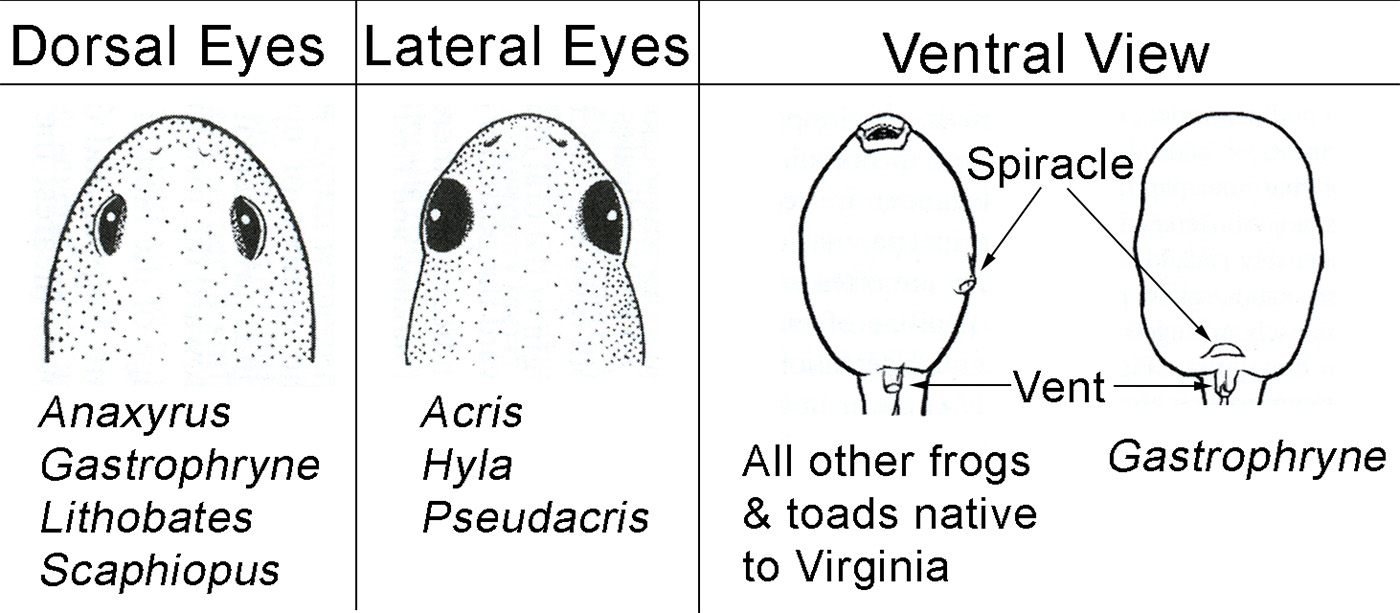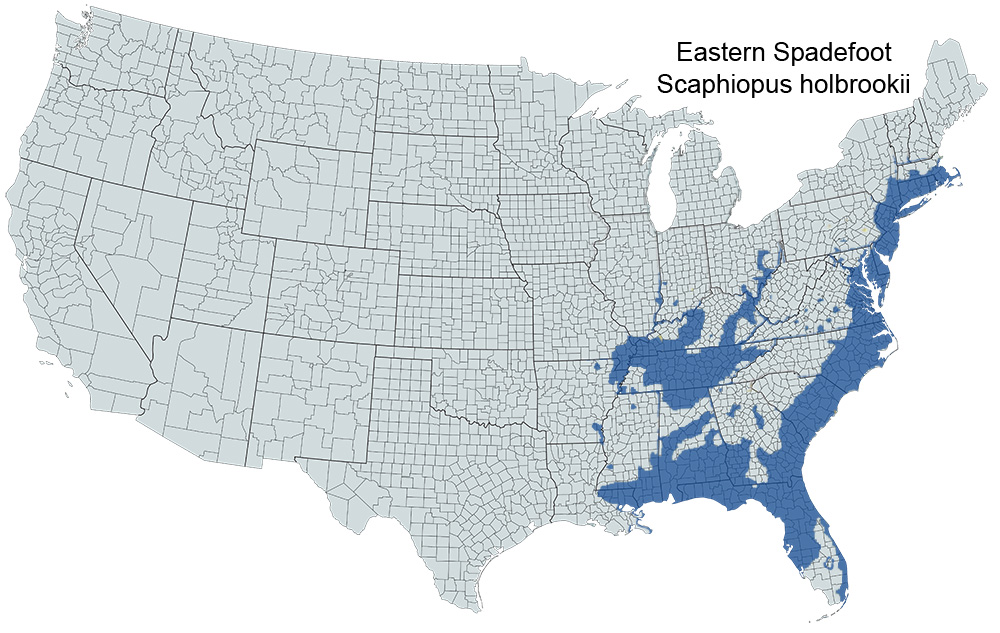Eastern Spadefoot
Scaphiopus holbrookii
Common Name: |
Eastern Spadefoot |
Scientific Name: |
Scaphiopus holbrookii |
Etymology: |
|
Genus: |
skaphis is Greek for "shovel or spade", pous is Greek for "foot". |
Species: |
holbrookii is in honor of John Edwards Holbrook (1794-1871). |
Average Length: |
1.75 - 2.25 in. (4.4 - 5.7 cm) |
Virginia Record Length: |
|
Record length: |
2.9 in. (7.3 cm) |
Physical Description - This species ranges in length from 44-72 mm (1 3/4 to 3 in.). It can be distinguished from other toads by its vertical, elliptical pupils and a spadelike, black horny projection on the inside of the foot. These projections are used for digging. This species is soft-bodied with short legs and moist skin. The skin may be covered with small tubercles. The dorsum is ususally brown but may range from gray to black. There are light bands running from the eye to vent and along the sides of this species. These bands are more yellow in male specimens. This species produces a musty peppery secretion that can cause an allergic reaction in some individuals. The throat and chest of this species are white; the lower belly is light gray to reddish in color. There is a pair of large pectoral glands.
Historical versus Current Distribution - Eastern Spadefoots (Scaphiopus holbrookii) range from Massachusetts and southeastern New York, south through the Atlantic Coastal Plain to the Florida Keys, west to southeastern Louisiana, southeastern and northeastern Arkansas, and southeastern Missouri. They range northward through western and eastern Kentucky into southwestern Illinois, southern Indiana, southeastern Ohio, and northwestern West Virginia (Conant and Collins, 1991; see also Giovannoli, 1936; Moody, 1986; Tugwell and Schwartz, 1991). Due to their cryptic habits and brief, irregular breeding bouts, the presence of Eastern Spadefoots is difficult to ascertain. The peripheral extent of Eastern Spadefoots is still being determined (e.g., Brandon and Austin, 1966; Klemens, 1993; Redmer and Ballard, 1995). Eastern Spadefoots no longer inhabit portions of their range due to habitat destruction (McCoy, 1982; Klemens, 1993).
Historical versus Current Abundance - Eastern Spadefoots can be locally abundant. For example, Carr (1940a) collected over 100 non-breeding individuals during one January night near Gainesville, Florida, and Pearson (1955) estimated populations of 196–621 Spadefoots/ac (79–251/ha) near Gainesville. Natural fluctuations in population size associated with annual variations in weather and reproductive success render status assessments of Spadefoot populations difficult (Klemens, 1993; Semlitsch et al., 1996). However, historical and recent accounts of the same Connecticut population provide examples of the magnitude of reduction that can occur as a result of habitat loss. Ball (1936) estimated the breeding population of Spadefoots at one pond to be 1,000 individuals in 1933 and 800 in 1935. Klemens (1993) reports that this population is now extirpated.
Breeding - Reproduction is aquatic.
Breeding migrations - Eastern Spadefoots are explosive breeders (Wells, 1977). Breeding activity is stimulated by sufficient rain at minimum temperatures of 7.2–10 ˚C (45–50 ˚F; Hansen, 1958; see also Green, 1948; Judy, 1969). Low temperatures can delay emergence for breeding by as much as 7 d following rains (Gosner and Black, 1955). Capable of breeding during any month in the south, Eastern Spadefoots breed from March–August in the north (Hansen, 1958; Mount, 1975; Ashton and Ashton, 1988; Klemens, 1993). Eastern Spadefoots have been captured up to 914 m (1,000 yd) from the nearest body of water (Dodd, 1996). Pearson (1955) determined that Eastern Spadefoots returned to their home sites, sometimes even to the same burrow, after breeding in a pond 0.4 km (0.25 mi) away.
Breeding habitat - Eastern Spadefoots breed in a variety of temporary water bodies, including temporary ponds in uplands and bottomlands, flooded fields and roads, roadside ditches and borrow pits (Carr, 1940a; Smith, 1961; Minton, 1972; Mount, 1975; Gibbons and Semlitsch, 1991). Rarely, they breed in permanent ponds (Hansen, 1958), including backyard goldfish ponds (Neill, 1950a). Neill (1957c) observed Spadefoots breeding in a freshly dug ditch.
Egg deposition sites - Eggs are attached to submerged vegetation, including the leaves and stems of grasses and forbs, stems and branches of shrubs and small trees, and twigs (Overton, 1915; Wright, 1932; Ball, 1936; Driver, 1936; personal observation). Egg masses are often deposited in select portions of breeding sites (Ball, 1936; Richmond, 1947; personal observation).
Clutch size - In Illinois, Eastern Spadefoots lay 3,078–5,468 eggs (mean = 3,872, n = 11; unpublished data). Wright (1932) reported a single clutch of 2,332 eggs from Georgia.
Altig & McDiarmid 2015 - Classification and Description:
- Eastern Linear
- Arrangement 2 - Eggs oviposited as wrapped rosaries.
- Sub-arrangement A - Eggs deposited in ephemeral, nonflowing water, can be mistaken for a clump or mass; Ovum Diameter 1.4-2.0 mm; Egg Diameter 4.0-5.6 mm; jelly flimsy.
- Arrangement 2 - Eggs oviposited as wrapped rosaries.
Length of larval stage - Eggs develop in 1–15 d, and the larval period ranges from 14–60 d depending upon water temperature (Wright and Wright, 1933; Richmond, 1947; Gosner and Black, 1955; Oliver, 1955a, cited in DeGraaf and Rudis, 1983; unpublished data).
Tadpoles:

| Lateral View | Dorsal View |
|---|---|
| BL = Body Length | IND = Internarial Distance |
| MTH = Maximum Tail Height | IOD = Interorbital Distance |
| TAL = Tail Length | TMW = Tail Muscle Width |
| TL = Total Length | |
| TMH = Tail Muscle Height |

Larvae Food - Larvae feed on phytoplankton, zooplankton, periphyton, dead plants and animals (e.g., earthworms, tadpoles), and anuran eggs, including their own (Driver, 1936; Richmond, 1947).
Cover - Eastern Spadefoot tadpoles do not use cover; depending on their age, they swim about individually in the water column or near the bottom or in large schools consisting of thousands of individuals. Compact schools of crowded tadpoles can be 1.2 x 2.4 m (4 x 8 ft), whereas less dense concentrations can be 0.6 x 9.1 m (2 x 30 ft; Richmond, 1947). Ball (1936) estimated that one school consisted of 12,000 tadpoles.
Larval polymorphisms - Not known to occur (Whiteman and Howard, 1998).
Features of metamorphosis - At metamorphosis, Spadefoots are 8.5–12.0 mm SVL (Wright, 1932). In Illinois, metamorphic animals average 14.8–15.3 mm and 0.3–0.5 gm (unpublished data).
Post-metamorphic migrations - Eastern Spadefoots metamorphose and emigrate from breeding sites en masse (Neill, 1957c, and references cited within; personal observation). Ball (1936) found a juvenile 200 m from the breeding site 35 d after metamorphosis.
Juvenile Habitat - Assumed to be similar to that of adults. The disappearance of juveniles from areas where they were previously observed suggests that they become fossorial 3.4–6.2 wk following metamorphosis in Illinois (personal observation) and about 6 wk post metamorphosis in Florida (Pearson, 1955).
Adult Habitat - Eastern Spadefoots occur in open and forested uplands and bottomlands, including ruderal habitats, that have friable, sandy to loamy soils (Stone, 1932; Driver, 1936; Pearson, 1955; Ashton and Ashton, 1988; Dundee and Rossman, 1989). Individuals can sometimes be found at the surface under logs (Smith, 1961). Pearson (1955) determined that Spadefoots use the same burrow for 1–713 d (0–24 mo) and emerge about 29 nights annually. Returning to his study area 2 yr after completing his investigation, Pearson (1957) found some individuals within the same home range and using the same burrows as when he last observed them. He concluded that these individuals had used the same burrow for 51 mo and inhabited the same home range for 59.5 mo.
Home Range Size - Eastern Spadefoots have an average home range of 10.1 m2 (108.4 ft2; Pearson, 1955).
Territories - Territorial behavior has not been observed in Eastern Spadefoots. However, Pearson (1955) noted that individuals do not share burrows and that home ranges rarely overlap, suggesting that individuals avoid each other.
Aestivation/Avoiding Dessication - In Florida, Pearson (1955) determined that reduced surface activity of Eastern Spadefoots in summer and winter is not attributable to aestivation or hibernation, but rather to a reduction in the number of nights having conditions suitable for Spadefoot surface activity during those seasons.
Seasonal Migrations - The only migrations known are those associated with reproduction.
Torpor (Hibernation) - Eastern Spadefoots hibernate at the northern end of their range (Klemens, 1993) but remain active throughout the year in the south (Pearson, 1955; Mount, 1975; Ashton and Ashton, 1988; Dundee and Rossman, 1989). Hibernation is sometimes interrupted by surface activity during unusually warm weather (Redmer and Karsen, 1990; personal observation).
Interspecific Associations/Exclusions - Eastern Spadefoots breed alone or in association with a variety of temporary-pond breeding anurans including Southern Cricket Frogs (Acris gryllus), American Toads (Anaxyrus americanus), Fowler's toads (A. fowleri), Eastern Narrow-mouthed Toads (Gastrophryne carolinensis), Cope's Gray Treefrogs (Dryophytes chrysoscelis), Pine Woods Treefrogs (Dryophytes femoralis), Barking Treefrogs (Dryophytes gratiosus), Spring Peepers (Pseudacris crucifer), Ornate Chorus Frogs (P. ornata), Strecker's Chorus Frogs (P. streckeri), Western Chorus Frogs (P. triseriata), Gopher Frogs (Lithobates capito), and Coastal Plains Leopard Frog (Lithobates sphenocephalus utricularius; Brimley, 1896, in Wright, 1932; Wright, 1932; Driver, 1936; Minton, 1972; Brown and Brown, 1973; personal observation). In the absence of predators, Eastern Spadefoot tadpoles out compete hylid tadpoles in artificial ponds (Morin, 1981, 1983b; Wilbur, 1987).
Age/Size at Reproductive Maturity - Eastern Spadefoots attain sexual maturity between 15–19 mo after metamorphosis (Pearson, 1955), at about 44 mm SVL (Conant and Collins, 1991).
Longevity - Captives have lived for 12 yr (Duellman and Trueb, 1986), whereas wild individuals at least 9 yr old have been reported (Pearson, 1955).
Feeding Behavior - Eastern Spadefoots feed on a variety of terrestrial arthropods (Carr, 1940a; Pearson, 1955; Punzo, 1992a; Jamieson and Trauth, 1996) during nocturnal forays away from or at the mouth of their burrows (Pearson, 1955; Punzo, 1992a).
Predators - Confirmed predators of juvenile and/or adult Eastern Spadefoots include southern toads (Bufo terrestris; Goin, 1955), American Bullfrogs (Lithobates catesbeianus; Holman, 1957), cottonmouths (Agkistrodon piscivorous; Gloyd and Conant, 1990), Eastern Hog-nosed Snakes (Heterodon platyrhinos; Hamilton and Pollack, 1956), Southern Hog-nosed Snakes (Heterodon simus; Goin, 1947a), Banded Watersnakes (Nerodia fasciata; Palis, 2000a), Northern Watersnakes (Nerodia sipedon; Palmer and Braswell, 1995), Southern Black Racers (Coluber constrictr priapus; Lynch, 1964), gulls (Larus sp.; Carr, 1940a), cattle egrets (Bulbulcus ibis; Jenni, 1969), starlings (Sturnus vulgaris; Palis, 2000a), opossums (Didelphis virginiana; Lynch, 1964), and raccoons (Procyon lotor; Lynch, 1964).
Anti-Predator Mechanisms - In the presence of predators, Eastern Spadefoots inflate their lungs to enlarge their bodies, crouch, or attempt to escape by burrowing backwards (Marchisin and Anderson, 1978; Duellman and Trueb, 1986). The fossorial habits of Eastern Spadefoots probably provide protection from visually oriented predators. Tadpoles appear to lack escape behaviors (Morin, 1985).
Diseases - Unknown.
Parasites - Unknown.
Conservation - Due to their secretive habits, the presence of Eastern Spadefoots is difficult to determine, and the peripheral extent of their populations is still being defined. McCoy (1982) and Klemens (1993) state that Eastern Spadefoots no longer inhabit portions of their range due to habitat destruction. Eastern Spadefoots are considered Rare in Missouri, a Species of Special Concern in Indiana, and Endangered in Ohio (Lannoo, 1998d).
References for Life History
- Altig, Ronald & McDiarmid, Roy W. 2015. Handbook of Larval Amphibians of the United States and Canada. Cornell University Press, Ithaca, NY. 341 pages.
- AmphibiaWeb. 2020. University of California, Berkeley, CA, USA.
- Conant, Roger and, Collins, John T., 2016, Peterson Field Guide: Reptiles and Amphibians, Eastern and Central North America, 494 pgs., Houghton Mifflin Company., New York
- Duellman, William E. and, Trueb, Linda, 1986, Biology of Amphibians, 671 pgs., The Johns Hopkins University Press, Baltimore
- Martof, B.S., Palmer, W.M., Bailey, J.R., Harrison, III J.R., 1980, Amphibians and Reptiles of the Carolinas and Virginia, 264 pgs., UNC Press, Chapel Hill, NC
- Wilson, L.A., 1995, Land manager's guide to the amphibians and reptiles of the South, 360 pp. pgs., The Nature Conservancy, Southeastern Region, Chapel Hill, NC
Photos:
*Click on a thumbnail for a larger version.
Verified County/City Occurrence
Accomack
Albemarle
Augusta
Bedford
Botetourt
Brunswick
Campbell
Caroline
Charles City
Charlotte
Chesterfield
Clarke
Craig
Culpeper
Cumberland
Dinwiddie
Essex
Fairfax
Fauquier
Fluvanna
Franklin
Frederick
Gloucester
Goochland
Greensville
Halifax
Hanover
Henrico
Highland
Isle of Wight
James City
King and Queen
King George
King William
Lancaster
Loudoun
Louisa
Lunenburg
Mathews
Mecklenburg
Middlesex
Montgomery
Nelson
New Kent
Northampton
Northumberland
Nottoway
Orange
Page
Pittsylvania
Powhatan
Prince George
Rappahannock
Richmond
Roanoke
Rockbridge
Rockingham
Shenandoah
Southampton
Stafford
Surry
Sussex
Westmoreland
York
CITIES
Buena Vista
Chesapeake
Danville
Franklin
Hampton
Newport News
Portsmouth
Radford
Richmond
Salem
Suffolk
Williamsburg
Verified in 64 counties and 12 cities.
U.S. Range




spade-sm.jpg)












